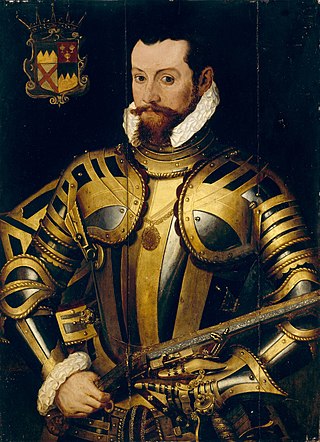Thomas Preston, 1st Viscount Tara was an Irish soldier of the 17th century. After lengthy service as a mercenary in the Spanish Army, Preston returned to Ireland following the outbreak of the Rebellion of 1641. He was appointed to command the Leinster Army of the Irish Confederacy, enjoying some success as well as a number of heavy defeats such as the Battle of Dungans Hill in 1647 where his army was largely destroyed. Like other Confederate leaders, Preston was a Catholic Royalist. He remained in close contact with the Lord Lieutenant the Marquess of Ormonde, and was a strong supporter of an alliance between Confederates and Royalists against the English Republicans.
The Lord Deputy was the representative of the monarch and head of the Irish executive under English rule, during the Lordship of Ireland and then the Kingdom of Ireland. He deputised prior to 1523 for the Viceroy of Ireland. The plural form is Lords Deputy.

Thomas Butler, 10th Earl of Ormond and 3rd Earl of OssoryPC (Ire), was an influential courtier in London at the court of Elizabeth I. He was Lord Treasurer of Ireland from 1559 to his death. He fought for the crown in the Rough Wooing, the Desmond Rebellions, and Tyrone's Rebellion. He fought his rival, Gerald FitzGerald, 14th Earl of Desmond in the Battle of Affane in 1565.
This is a list of people who have served as Lord Lieutenant of Surrey. Since 1737, all Lords Lieutenant have also been Custos Rotulorum of Surrey.
Gentleman of the Bedchamber was a title in the Royal Household of the Kingdom of England from the 11th century, later used also in the Kingdom of Great Britain. A Lord of the Bedchamber was a courtier in the Royal Household; the term being first used in 1718. The duties of the Lords and Gentlemen of the Bedchamber originally consisted of assisting the monarch with dressing, waiting on him when he ate, guarding access to his bedchamber and closet and providing companionship. Such functions became less important over time, but provided proximity to the monarch; the holders were thus trusted confidants and often extremely powerful. The offices were in the gift of The Crown and were originally sworn by Royal Warrant directed to the Lord Chamberlain.
Charles Wilmot, 1st Viscount Wilmot of Athlone was an English soldier active in Ireland.
The Lord High Treasurer of Ireland was the head of the Exchequer of Ireland, and chief financial officer of the Kingdom of Ireland. The designation High was added in 1695.

Francis Annesley, 1st Viscount Valentia, was an English statesman during the colonisation of Ireland in the seventeenth century. He was a Member of Parliament for both the English and Irish houses, was elevated to the Irish peerage as Baron Mountnorris, and later gain the additional title Viscount Valentia. He is best remembered for his clash with the Lord Lieutenant, Thomas Wentworth, who in order to render Annesley powerless had him sentenced to death on a spurious charge of mutiny, although it was clearly understood that the sentence would not be carried out.
Thomas Butler, Viscount Thurles was the son and heir apparent of Walter Butler, 11th Earl of Ormond (1559–1633), whom he predeceased. He lived at the Westgate Castle in Thurles, County Tipperary. He was accused of treason but drowned in a shipwreck off the Skerries in the Irish Sea, before he could be judged. He was the father of the Irish statesman and Royalist commander James Butler, 1st Duke of Ormonde.

